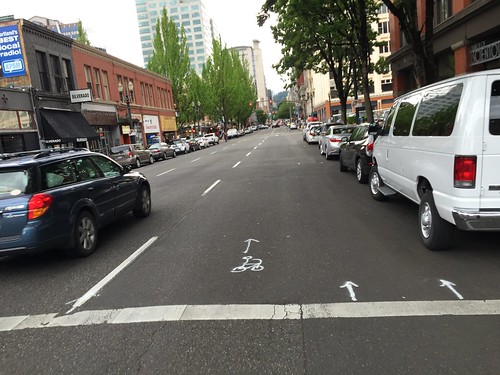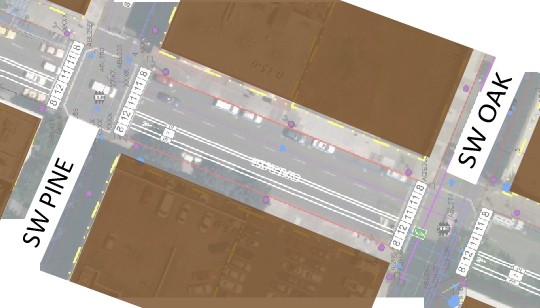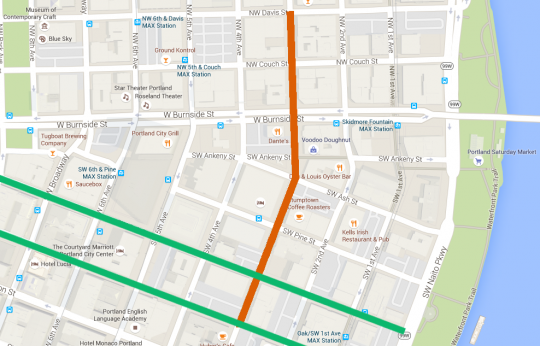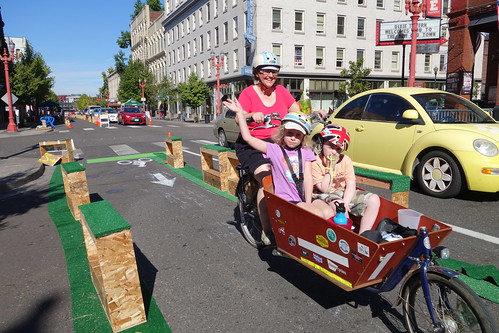
(Photo: J.Maus/BikePortland)
Less than a year after a handful of businesses and volunteers hectored the city into letting them test a bike lane on SW Third Avenue in Old Town, one is about to be installed — probably next month.
“It was really interesting to have a coalition of the bar owners, the social service providers and the city working together collaboratively to refine the design.”
— Ryan Hashagen, chair of 3rd Avenue Stakeholder Advisory Group
The new right-side buffered bike lane will run from NW Davis south to the green bike lane on SW Stark, city officials and a neighborhood represntative said in a joint interview Tuesday.
It’ll be one of just three southbound bike lanes in downtown Portland, and the only bike lane in downtown to include a painted buffer.
In fact, Third Avenue’s new bike lane will have two buffers: a two-foot one on the left, between bike and car traffic, and a three-foot one on the right, to give room for car doors. Between the buffers, the bike lane itself will be mostly seven feet wide, narrowing to six feet at points where the parking lane widens to make room for a truck loading zone.


As we reported in June, the plan was the unanimous recommendation of 3rd Avenue Stakeholder Advisory Group, which is part of the Old Town Chinatown Community Association.
“This started out as a discussion in the neighborhood about the entertainment district,” said Ryan Hashagen, chair of the advisory group and a volunteer for last October’s Better Block PDX demonstration on 3rd Avenue. “It became, quickly, a larger conversation about how to build livability, how to make it more enjoyable 24 hours a day. … It was really interesting to have a coalition of the bar owners, the social service providers and the city working together collaboratively to refine the design.”
In addition to the bike lanes, the city will mark new crosswalks and add a left-turn box for people biking west from the Burnside Bridge and turning south onto Third. Just north of the corner of Burnside and 3rd, the bike lane will disappear and become a mixing zone with right-turning traffic.

(Image: BikePortland)
Bureau of Transportation project manager Rick Browning said that until earlier this week, the city was planning to install the new bike lane this weekend. But because rain is forecast, it’ll instead happen on the first dry weekend after Labor Day.
“Creating a more vibrant space for people of all stripes can create a more vibrant business environment,” said Hashagen, whose Portland Pedicabs business has an office in Old Town.
Hashagen’s view is shared by the community association’s chair and by many other business owners on the street, though not by the Portland Business Alliance, the regional chamber of commerce. Lisa Frisch, the PBA’s downtown retail development manager, told us in June that she believes there is zero connection between the number of traffic lanes on a street and the desire of people to spend time and money nearby.
Some compromises, but 100 percent consensus
In order to get 100 percent consensus, the stakeholder committee that included Frisch agreed on two lanes of auto traffic for the full length of the project despite 3rd Avenue’s low traffic counts south of Burnside. It also agreed to preserve every parking space on the street.
In combination, those two measures meant that the bike lanes won’t be able to offer any physical separation.
Advertisement
Timur Ender, a transportation policy advisor to City Commissioner Steve Novick, said the new buffered lanes might lay the groundwork for other changes.
“This is just the first phase of improvements — if the community sees a need for further improvement, that can be a conversation down the road,” said Endur, who was also a volunteer on the Better Block project before he joined Novick’s team. “We can explore that as part of the central city multimodal plan.”
The Central City Multimodal Safety Project, currently gathering speed, is a $6.6 million effort widely expected to include downtown’s first protected bike lanes.
Ender said that PBOT engineers calculate that with 3rd Avenue’s traffic counts, there will be no additional delay for people driving on the street.
A new model for public outreach?

(Photo: Greg Raisman)
In some ways, the 3rd Avenue project is being done with little public outreach. There’s been no city-led open house, no page on the city’s website. The city ignored a request from BikePortland, under the state’s open-records law, to make public a rendering of the street that was already being vetted with businesses and residents.
In other ways, though, it’s one of the most public bike projects the city has ever done.
“The Better Block pilot project has been an engagement to the entire city,” Hashagen argued. “The Oregonian reported on it. We had TV stations there. … The overwhelming reaction of the pilot project was ‘When is this going to be done? How quick can this be implemented?'”
The three-day pilot project, of course, was different. It eliminated on-street auto parking and two passing lanes to create a huge public plaza outside Voodoo Doughnut. It protected the bike lane with wooden planters. And it stopped several blocks further north.
“This isn’t the be-all end-all for Old Town Chinatown. This is one step among many that we intend to take.”
— Chad Stover, office of Mayor Charlie Hales
Ender said Hashagen and a city transportation staffer went door to door this summer to every storefront on Third Avenue, and that the city mailed a description to every business with a Third Avenue address.
“Every single one of the businesses that we went to was for the most part excited to see changes to the neighborhood,” Hashagen said.
Ender said a much smaller version of the plaza outside Voodoo Doughnut will be installed early in next year’s work season. Some details about its design are yet to be worked out between the Old Town Chinatown Community Association, the Ankeny Alley Association and the city.
Chad Stover, a project manager for Mayor Charlie Hales, said Tuesday that he thinks Old Town Chinatown will eventually want to create a “business improvement district” that would let businesses pool their money in exchange for control over further changes to the area.
“This isn’t the be-all end-all for Old Town Chinatown,” Stover said. “This is one step among many that we intend to take.”
Correction 10:25 pm: An earlier version of this post said this would be the first buffered bike lane downtown. The lanes on Stark and Oak were previously buffered and are now wide colored lanes. This’ll be the only buffered lane downtown.



